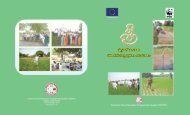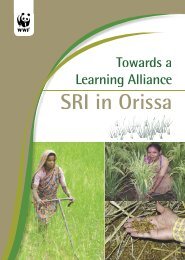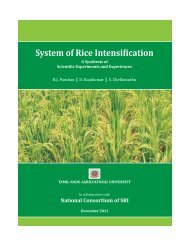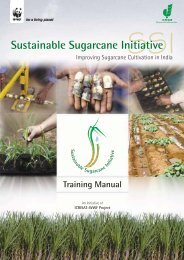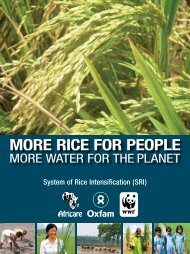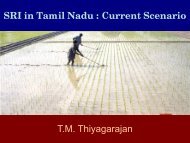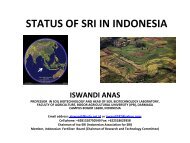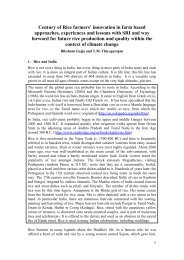SSI Newsletter - SRI - India
SSI Newsletter - SRI - India
SSI Newsletter - SRI - India
You also want an ePaper? Increase the reach of your titles
YUMPU automatically turns print PDFs into web optimized ePapers that Google loves.
<strong>SSI</strong>: A New Experience<br />
in Sugarcane Cultivation<br />
Triveni Industries, as a sugar industry took the first pioneering step in<br />
implementing the <strong>SSI</strong> methods in UP – in the form of trial plots in 4<br />
districts – to improve upon the present sugarcane scenario both for the<br />
industry and farmers. And now, encouraged by the results, they plan to<br />
extend the <strong>SSI</strong> methods further in 60 ha this autumn season, including<br />
about 50 ha in the farmers’ field.<br />
As a consequence, the period<br />
for tillering phase is reduced<br />
significantly.<br />
• Narrow spacing between rows –<br />
the distance between two rows is<br />
generally 60-70 cm or even low.<br />
This causes competition for sun<br />
light and air among the tillers,<br />
which in turn causes severe tiller<br />
mortality and heterogeneous cane.<br />
Shri. P. K. Singh<br />
Background<br />
The role of sugarcane in uplifting rural<br />
economy particularly in the Northern<br />
plains of <strong>India</strong> is well accepted. Even<br />
after contributing significantly, sugarcane<br />
has over the years lost its place<br />
of prominence in farmers’ field and<br />
farmers today consider sugarcane<br />
as one of many alternatives. Several<br />
factors can be attributed for this<br />
decline. The first and foremost is the<br />
reduction in returns per unit area<br />
of sugarcane, in spite of increase in<br />
cane prices. This is mainly because of<br />
lower yields and increase in the cost<br />
of inputs.<br />
The paying capacities of the factories<br />
have also dwindled because of lower<br />
sugar recovery, affecting the cane<br />
payment to farmers which has<br />
further aggravated the situation.<br />
The interest and confidence of<br />
the farmer in sugarcane can only<br />
be restored if he is sure of better<br />
returns on sustainable basis. The<br />
three variables affecting the returns<br />
are yield per unit area, cost of<br />
cultivation and certainly the price<br />
of the output. The third variable is<br />
largely dependent on many volatile<br />
factors and Government polices,<br />
which are generally not in the hands<br />
of the farming community and the<br />
scientists. But the first two variables<br />
i.e. yield and cost of production<br />
can certainly be addressed. Several<br />
attempts have been made in the<br />
past and some new ones are being<br />
tried for improving yields.<br />
It is not that the new technologies<br />
tried have not given results, but the<br />
fact remains that even after giving<br />
results, those technologies could not<br />
be further scaled up. This is either<br />
due to some adaptability issue or<br />
a cumbersome process difficult to<br />
understand or even due to last minute<br />
cost enhancement. It is important<br />
that the technology is farmer friendly,<br />
economical and easy to implement in<br />
order to improve yields on a sustainable<br />
basis. However, before getting into<br />
the technological aspects, it is better<br />
to understand the problems and the<br />
factors affecting cane yield in U.P.<br />
Lower yields in U.P can be attributed<br />
to the following factors:-<br />
• Late planting of sugarcane –<br />
most of the planting is done<br />
after the harvest of wheat in the<br />
month of April and May, thus<br />
reducing the life span of the crop.<br />
• Inadequate and imbalanced fertilizer<br />
dosage with more focus on<br />
use of Nitrogenous Fertilizer.<br />
• Over dependence on monsoons<br />
is adversely affecting the yields<br />
especially in the case of failure<br />
of or variation in the monsoon<br />
pattern.<br />
• Lower yields in ratoons due to<br />
improper ratoon management<br />
practices.<br />
• Irrigation method followed led not<br />
only to wastage of water but also<br />
created anaerobic condition in the<br />
field. Also, high cost of irrigation<br />
affect the frequency of irrigation.<br />
There are several other factors<br />
relating to field preparation, seed<br />
quality, use of organic manure, plant<br />
Triveni Industry staff visiting the sugarcane fields in Andhra Pradesh<br />
Nov ‘09<br />
15<br />
SugarCane<br />
matters



